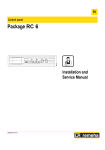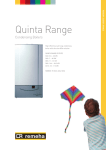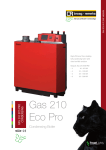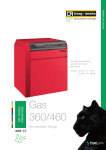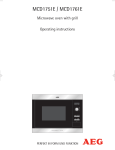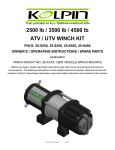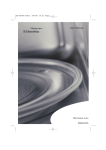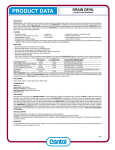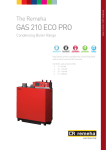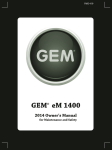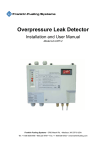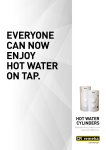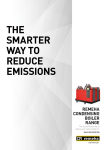Download Remeha Avanta Plus P SERIES Brochure
Transcript
REMEHA PRESSURE JET RANGE P Series Pressure Jet Range Gas, Oil and Dual fuel pressure jet three-pass cast iron sectional boiler with low NOx emissions PRESSURE JET OUTPUTS P 320: 70-330 kW P 420: 300-780 kW P 520: 696-1450 kW Introduction Boiler Description The Remeha P Series Range is a family of advanced technology boilers, giving value for money when used on both commercial and industrial applications. All the models are suitable for gas, oil, dual fuel and bio-fuel. They are compact in size yet designed to be extremely powerful, meeting all requirements on both full and part load giving high operating efficiency and low emissions. The Remeha Pressure Jet Range are high efficiency pressurised hot water boilers suitable for use with natural gas, light oil and bio fuel, by means of a pressure jet burner. Nominal output of the P 320 boilers is between 70 and 330 kW, the P 420 boilers is between 300 and 780 kW and the P 520 boilers is between 754 and 1450 kW. The main boiler casing is steel, with a powder coated enamel finish complete with high quality 80-100mm thick glass wool insulation. The front door is suitable for left or right opening allowing easy access for service operations. The heat exchanger is manufactured from corrosionresistant ‘Eutectic’ cast iron. The instrument panel contains all the necessary control and measuring instruments required to control the boiler with the external connections on a terminal strip. The capillaries and sensor wires of the control panel are placed in the instrument pockets fitted at the front of the boiler. For the discharge of flue gases, chimney draught is not required. Tests have shown that very good combustion results are obtained with zero draught at the boiler outlet. The boilers are suitable for open and sealed systems up to a maximum pressure of 6 bar and a minimum pressure of 0.8 bar. The boiler is suitable for installation in basement or rooftop plant rooms. The sizes of boilers parts are such that they can enter the plant room through a normal entrance. The casing and instrument panel are packed separately. The boiler block consists of cast iron sections which are assembled by means of tapered nipples and ceramic rope. The boilers are designed on the basis of the triple pass principle for maximum efficiency and a generously sized combustion chamber for minimising NOx production. Contents 2 page Introduction 2 Boiler Description 2 Typical Boiler Construction 3 Advantages at a Glance 3 P 320 Dimensions & Technical Data 4-5 P 420 Dimensions & Technical Data 6-7 P 520 Dimensions & Technical Data 8-9 Application Information 10 Instrument Panels 10 External Connections 10 Water Treatment 11 In principle, all EC approved pressure jet burners are suitable subject to boiler capacity and construction. The boilers meet the requirements of the EC regulations in the following directives: - - - - - 97/23/Sound engineering (article 3.3) 90/396/Gas appliance directive 73/23/Electrical low voltage directive 89/336/E.M.C. directive 92/42/Efficiency directive Classification type for evacuation of the combustion products: B23. Advantages at a glance Typical Boiler Construction Remeha P 320 7 8 • Boiler body with 3-pass flueways design with a large combustion chamber and horizontal flue passes with fins. The heat transfer is enhanced by the fins and the cast iron baffles 1 2 • A high combustion efficiency 3 6 • A low noise level operation 5 • Optimal combustion with low NOx and CO2 emissions 4 • Easy adaptation to traditional burners, as well as new burners with low NOx emissions Remeha P 420 7 8 • Hinged burner / cleaning door (right hand side or left hand side) 1 2 3 6 • Eutectic cast iron boiler body provides exceptional resistance to temperature variations, thermal shocks and corrosion • Safe low modulated temperature operation down to 40°C 5 • Reinforced fibreglass wool insulation (100 mm) and double insulation of the boiler front which minimises heat loss and allows reduced stand-by consumption and improved thermal efficiency 4 Remeha P 520 7 • Internal electrical duct for wiring connections 1 • Easy installation for existing or new boiler houses 2 6 3 5 8 4 • The assembly of the sectional boiler body can be carried out anywhere even in boiler houses with difficult access • A maximum working pressure of 6 bar allows for most types of installation • Volt free wiring connections for external run and lock-out indication 1 Boiler body with pass flue ways 6 Flame observation window 2 Large-sized combustion chamber 7Control panel designed to enable easy wiring connections 3 Complete insulated boiler body with fibreglass wool, 100 mm thick 4 Ceramic fibre insulated burner door 5 Hinged burner door fitted (right hand side or left hand side) 8 Eutectic cast iron body, thermal shock and corrosion resistant, allowing low modulated temperature operation and complete stop between two heating periods 3 Remeha P 320 Dimensions All measurements in mm Front View Side View Rear View Dimensions of the Sections Remeha P 320 Number of sections L (mm) P (mm) ØR (mm) Flow and Return connection sizes 4 4 5 6 7 8 9 991 490 180 2.5” 1151 650 180 2.5” 1311 810 180 2.5” 1471 970 200 2.5” 1631 1130 200 2.5” 1791 1290 200 2.5” Maximum operating pressure: 6 bar. Boiler thermostat setting: 20 to 90 ºC. Safety thermostat setting: 110 ºC. Remeha P 320 Number of Sections Nominal output Nominal input Efficiency 100% load (NCV) Seasonal efficiency (GCV) Water contents Water resistance T=11°C (1) T=15°C (1) T=20°C (1) Pressure in the furnace for nozzle pressure = 0 Flue gas temperature(1)(3) Mass flue gas flow rate(1)(2) Gas Combustion chamber diameter Standing losses T=50c Shipping Weight 4 5 6 7 8 9 kW kW % % Iitre mbar mbar mbar 70-105 76-117 88 83.4 96 11.54 6.2 3.47 105-140 115-156 88 83.6 116 20.3 10.9 6.11 140-180 153-199 88 83.6 136 37.8 20.4 11.45 180-230 197-253 88 84 156 56 30 16.94 230-280 252-309 88 84.2 176 82.5 44.5 24.96 280-330 305-361 88 84.2 196 119 63.8 35.93 mbar +0.3 +0.6 +1.1 +1.6 +2.2 +2.5 °C Kg/h mm % kg <210 187 377 0.17 636 <210 250 377 0.14 755 <210 321 377 0.13 907 <210 410 377 0.11 1037 <210 499 377 0.10 1169 <210 588 377 0.09 1304 Nominal operation (Top boiler power) CO2 = 13.1 to 13% with fuel oil and 9.5% with natural gas (3) Boiler temperature 80°C (1) (2) Minimum Boiler Base Dimensions Remeha P 320 REMEHA PRESSURE JET RANGE Technical Data Remeha P 320 Number of sections 4 5 6 7 8 9 L (mm) 838 998 1158 1318 1478 1638 C min = 1.5 mtrs min and max dependent on make and model of burner The Remeha P 320 boilers do not require a special base for their assembly. Their closed furnace system means that the floor need not have refractory properties. Ensure that the floor can support the weight of the boiler when it is fitted for operation. If the boiler location is not determined precisely, leave enough space around the boiler to facilitate monitoring and maintenance operations. 5 Remeha P 420 Dimensions All measurements in mm Front View Side View Rear View Dimensions of the Sections Remeha P 420 Number of sections 8 9 10 11 12 13 ØA (mm) 250 250 250 300 300 300 ØB (mm) 2.5” 2.5” 2.5” 3” 3” 3” ∆ T=10ºC(1) ØC (mm) Plate intact or pre-drilled to the diameter specified on order ∆ T=15ºC(1) D (mm) 235 235 235 254 254 254 ∆ T=20ºC(1) E (mm) 1427 1427 1427 1447 1447 1447 J (mm) 1800 1950 2120 2305 2465 2625 L (mm) 1505 1665 1825 1985 2145 2305 S (mm) 1183 1343 1503 1663 1823 1983 6 14 300 3” 254 1447 2785 2465 2143 Maximum operating pressure: 6 bar. Boiler thermostat setting: 30 to 90 ºC. Safety thermostat setting: 110 ºC. Remeha P 420 Number of Sections Nominal output Nominal input Efficiency 100% load (NCV) Seasonal efficiency (GCV) (Avg) Water contents Water resistance T=11°C (1) T=15°C (1) T=20°C (1) Pressure in the furnace for nozzle pressure = 0(1)(3)(2) Flue gas temperature(1)(3) Mass flue gas flow rate(1)(2) Gas Combustion chamber diameter Maintenance consumption @50c Shipping Weight 8 9 10 11 12 13 14 kW 300-390 390-450 450-540 540-600 600-670 670-720 720-780 kW 329-434 429-502 495-599 594-670 661-751 737-804 789-871 % 88 88 88 88 88 88 88 % 82.2 82.2 82.2 82.2 82.2 82.2 82.2 Iitre 366 409 452 495 538 581 624 mbar 31.4 59.35 74.35 89.13 110.77 132.17 178.69 mbar 14 21 36 45 58 70 87 mbar 8 12 20 25 33 40 49 mbar +1.1 +1.5 +2.0 +2.5 +2.5 +2.5 +3.5 °C Kg/h mm W kg <220 700 530 315 1978 <220 810 530 358 2194 <220 972 530 413 2399 <220 1080 530 451 2653 <220 1207 530 494 2836 <220 1297 530 505 3070 <220 1405 530 555 3296 Nominal operation (Top boiler power) CO2 = 13.1 to 13% with fuel oil and 9.5% with natural gas (3) Boiler temperature 80°C (1) (2) Minimum Boiler Base Dimensions Remeha P 420 REMEHA PRESSURE JET RANGE Technical Data Remeha P 420 Number of sections L (mm) 8 9 10 11 12 13 14 1505 1665 1825 1985 2145 2305 2465 C min = 1.5 mtrs min and max dependent on make and model of burner The Remeha P 420 boilers do not require a special base for their assembly. Their closed furnace system means that the floor need not have refractory properties. Ensure that the floor can support the weight of the boiler when it is fitted for operation. If the boiler location is not determined precisely, leave enough space around the boiler to facilitate monitoring and maintenance operations. 7 Remeha P 520 Dimensions All measurements in mm Front View Side View Dimensions of the Sections Remeha P 520 Number of sections A (mm) B (mm) C (mm) D (mm) ØE (weld) (mm) ØF (mm) G (mm) H (mm) K** (mm) L (mm) M (mm) P (mm) R (mm) S (mm) T (mm) U (mm) 13 1563 1522 ∆ T=10ºC(1) 1488 ∆ T=15ºC(1) 256 ∆ T=20ºC(1) 139.7 350 - 37 49 1955 275 355 175 1760 1372 2021.5 15 17 19 21 23 25 1785 1744 1488 188 139.7 400 150 -31 -19 2245 324 355 175 1760 1594 2243.5 2007 1966 1488 210 139.7 400 370 -9 3 2445 321 355 175 1760 1816 2465.5 2229 2188 1504 257 159 400 370 13 25 2645 299 355 175 1760 2038 2687.5 2491 2450 1504 209 159 * 650 -35 -23 2955 324 355 175 1760 2300 2949.5 2713 2672 1504 231 159 * 980 -13 -1 3155 324 355 175 1760 2522 3171.5 2935 2894 1504 253 159 * 980 9 21 3355 303 355 175 1760 2744 3393.5 * Plain plate, requires cutting. Maximum cut-out 500 x 700 ** Dimension representing the end of the 100 mm long chimney connection G = Length required for clearing the water distributing tube Note: with models P 520-21, P 520-23 and P 520-25, a plain plate which must be cut out is supplied without the 100 mm chimney connection 8 Maximum operating pressure: 6 bar. Boiler thermostat setting: 30 to 90 ºC. Safety thermostat setting: 110 ºC. Remeha P 520 Number of Sections Nominal output Nominal input Efficiency 100% load (NCV)(3) Seasonal Efficiency (GCV) Water capacity Water resistance T=11°C T=15°C T=20°C Pressure in the furnace for nozzle pressure = 0 Flue gas temperature(1)(3) Mass flue gas flow rate(1)(2) Fuel oil Gas Maintenance consumption T=30k Shipping Weight 13 15 17 19 21 23 25 kW 696-754 812-870 928-986 1044-11021160-1218 1276-13341400-1450 kW 763-831 897-967 1022-1093 1146-12161265-1336 1393-14641532-1595 % 90.7 90 90 90 90 90 90 % 84.1 84.3 84.3 84.5 84.5 84.2 84.8 Iitre 617 693 769 845 943 1019 1095 mbar 47.53 64.13 25.10 34.39 44.28 53.58 64.79 mbar 25.8 34.7 13.5 18.5 24 29 35 mbar 14.4 19.4 7.6 10.4 13.4 16.2 19.6 mbar 2.2 2.4 2.6 2.85 3.1 3.3 3.5 °C Kg/h Kg/h % kg <190 1070 1120 0.08 3139 <190 1220 1280 0.07 3541 <190 1370 1440 0.07 3966 <190 1520 1590 0.07 4372 <190 1670 1750 0.06 4810 <190 1820 1910 0.06 5190 <190 1970 2070 0.06 5605 Nominal operation (Top boiler power) CO2 = 13.1 to 13% with fuel oil and 9.5% with natural gas (3) Boiler temperature 70°C (1) (2) Minimum Boiler Base Dimensions Remeha P 520 REMEHA PRESSURE JET RANGE Technical Data * In order to facilitate subsequent work on the boiler (replacing the water distributing tube etc.) use a flanged connection from the boiler to the system, making sure you comply with minimum clearance dimension D If A = 1.2 m (door opening side), A’ = 0.5 m If A = 0.5 m, A’ = 1.2 m (door opening side) : adapt the dimensions on the basis of the dimensions of the burner when the door is open B = 1.5 m : adapt the dimensions on the basis of the dimensions of the burner Remeha P 520 Number of sections L (mm) M (mm) C min. D min. 13 15 17 19 21 23 25 1955 275 300 - 2245 324 436 136 2445 321 656 356 2645 299 656 356 2955 324 936 636 3155 324 1266 966 3355 303 1266 966 For the assembly and because of their design, P 520 boilers require no special base. Their closed furnace system means that the floor need not have refractory properties. All you have to ensure is that the floor can support the weight of the boiler when it is fitted for operation. If the boiler location is not determined precisely, leave enough space around the boiler to facilitate monitoring and maintenance operations. 09 Application Information Water flow in the boiler : The water flow in the boiler when the burner is operating must correspond with the following formulae: - Nominal water flow Qn = 0.86 Pn/20 - Minimum flow Qmin = 0.86 Pn/45 (this flow also corresponds with the minimum recycle flow in the boiler) - Maximum water flow Qmax = 0.86 Pn/5 Qn = flow in m3 /h Pn = Nominal output (full boiler output) in kW Operation in cascade After stopping the burner: - Timeout required before the order to close a 2 way valve: 3 min - Switch a possible shunt pump (located between the boiler and a butterfly valve) off via the end of run contact of the butterfly valve Operation with 2-stage burner - The water temperature in the boiler is maintained at 50°C or more: the first stage must be set to a minimum of 30% of the nominal stage - Operation at modulated low temperature (minimum outlet temperature: 40°C): the first stage must be set to a minimum of 50% of the nominal stage Operation with modulating burner - The water temperature in the boiler is maintained at 50°C or more: the burner can modulate down to 30% of the nominal stage - Operation at modulated low temperature (minimum outlet temperature: 40°C): the burner can modulate down to 50% of the nominal Instrument Panels 3-position switch: - auto - manual - safety thermostat test 10 amp circuit breaker Burner alarm light with reset button Number of burner stages selection switch 110°C safety thermostat with manual reset 1st and 2nd-stage indicators Slot for the flue gas thermometer (available as option) Boiler thermometer Switch burner/heating pump On/Off switch 1st and 2nd- stage thermostats adjustable from 30 to 90°C Slot for hour run meters External Connections Shunt Pump Supply - 230-1-50 (If over 2 amp max. use relay to control) Note: This supply is live all the time boiler is switched on System Pump Supply - 230-1-50 (If over 2 amp max. use relay to control) Note: This supply is only live when via the summer/winter switch on panel Burner lock out alarm remote signal - 230v signal C002863-A External control Terminal Block External On/Off control - volt free switch to carry 230v signal External High/Low control - volt free switch to carry 230v signal Flying lead from terminals Plug set CA in panel To use the External On/Off and High Low controls connections remove plug from CA set and place flying lead plug in its place Boiler run indication Volt free Burner Alarm indication Volt free 10 Burner Alarm indication Volt free 2 High Temperature alarm remote indication - 230v signal Boiler power supply 230v - 1 - 50 Fuse rating 10 amps Boiler run indication Volt free 2x0,75 mm2 mini. External Interlock (ie: Flow Switch) Remove link to use Note: This carries a 230v signal 2x0,75 mm2 mini. Main Terminal Block Outlet boiler run (Volt free contact): Maximum admissible current: 16 A / 230 V. Outlet boiler alarm (Volt free contact): Maximum admissible current: 16 A / 230 V. The system should be filled with mains cold water (for the UK this will usually have a pH of between 7 and 8). Pressurised installations with a boiler/ system content ratio of 1:10 or less should not require water treatment, provided that the following conditions apply: 1. The system is flushed thoroughly to remove all fluxes and debris and then filled completely once. 2. Make up water is limited to 5% per annum. 3. The hardness of the water does not exceed 360 ppm (20°D). All scale deposits will reduce the efficiency of the boiler and should be prevented. However, provided the above is complied with, any scale produced will not be too detrimental to the boiler efficiency and will not reduce the anticipated life expectancy of the boiler. Note: Scale deposits in excess of 3 to 5 mm will reduce boiler efficiency and greatly increase the risk of premature casting failure. As most systems contain a variety of metals which can react with each other to cause corrosion, it is considered good practice to provide some form of water treatment (especially in open vented systems) in order to prevent or reduce the following: - Metallic corrosion - Formation of scale and sludge - Microbiological contamination Suitable chemicals and their use should be discussed with a specialist water treatment company prior to carrying out any work. The specification of the system and manufacturers’ recommendations must be taken into account, along with the age and condition of the system. New systems should be flushed thoroughly to remove all traces of flux, debris, grease and metal swarf generated during installation. Care to be taken with old systems to ensure any black metallic iron oxide sludge and other corrosive residues are removed, again by thoroughly flushing, ensuring that the system is drained completely from all low points. Note: Please ensure that the new boiler plant is not in circuit when the flushing takes place, especially if cleansing chemicals are used to assist the process. UNDER NO CIRCUMSTANCES IS THE BOILER TO BE OPERATED WITH CLEANING CHEMICALS IN THE SYSTEM. REMEHA PRESSURE JET RANGE Water Treatment To Summarise: - Minimise water loss - Prevent pumping over in open vented systems - Provide adequate air venting at all high points - Keep pH level between 7 - 9 when using additives - Maximum chlorine content of 200 mg/l - Take advice on the suitability of inhibitors - Chemical changes in the untreated system water 11 Remeha House Molly Millars Lane Wokingham Berkshire RG41 2QP T: 0118 978 3434 F: 0118 978 6977 E: [email protected] www.remeha.co.uk The data published in this technical sales leaflet is based on the latest information (at date of publication) and may be subject to revisions. It should be read in conjunction with our full technical brochure (available on request). We reserve the right to continuous development in both design and manufacture, therefore any changes to the technology employed may not be retrospective, nor may we be obliged to adjust earlier supplies accordingly. Issue 7 date: 01/11/12 TreadLightly ON THE PLANET Remeha is committed to carbon offsetting Designed and produced by Sans Frontiere Marketing Communications – 01273 487 800 – www.sansfrontiere.co.uk Remeha Commercial Head Office












